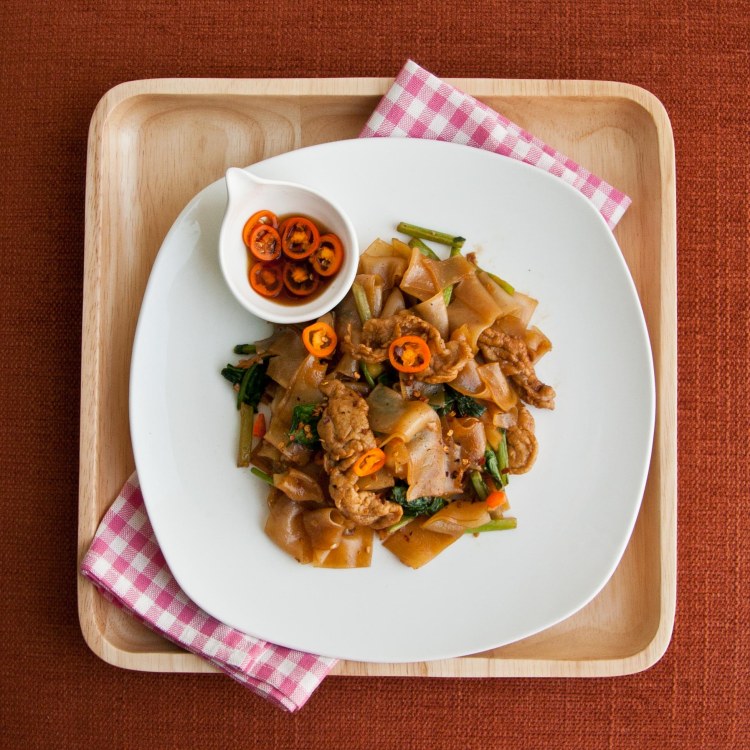 Phat sii iw (ผัดซีอิ๊ว)— which literally means ‘stir-fried soy sauce’—made a recent appearance in my kitchen when I decided to try my hands at cooking this common street food in Thailand. Phat sii iw is a Chinese-influenced stir-fried dish that is similar to char kway teow in Singapore and Malaysia. Well, its name in Thai already alludes to its Chinese provenance.
Phat sii iw (ผัดซีอิ๊ว)— which literally means ‘stir-fried soy sauce’—made a recent appearance in my kitchen when I decided to try my hands at cooking this common street food in Thailand. Phat sii iw is a Chinese-influenced stir-fried dish that is similar to char kway teow in Singapore and Malaysia. Well, its name in Thai already alludes to its Chinese provenance.
Like any stir-fried dish, phat sii iw needs one vital component—a wok on high heat—to give it that distinctive wok smell, better known as wok hei in Cantonese or wo qi (镬气) in Chinese. There were many times when Mr. P and I wondered why we couldn’t whip up a favourite restaurant dish at home with similar results, and the explanation we came up with, apart from our lesser culinary skills, was the lack of a highly heated wok—think seasoned woks with high flames in zi char stalls in Singapore and any Chinese kitchen around the world. But alas, most home cooks like me will find it hard to recreate wok hei with just an electric stove, hence I’m craving for a gas stove in the near future where I’ll have better control of the cooking fire.
 In Thailand, noodles are simply referred to as kuay tiao with specific names for the different types, such as sen yai, sen lei, ba mii and wun sen. So in this case, what is known as guo tiao/kway teow in Singapore is called sen yai (wide flat rice noodles) in Thailand, which means ‘big strips’ in Thai. I will usually cut the noodles into shorter strands first before cooking, otherwise it will be quite hard to stir-fry them around in my pan.
In Thailand, noodles are simply referred to as kuay tiao with specific names for the different types, such as sen yai, sen lei, ba mii and wun sen. So in this case, what is known as guo tiao/kway teow in Singapore is called sen yai (wide flat rice noodles) in Thailand, which means ‘big strips’ in Thai. I will usually cut the noodles into shorter strands first before cooking, otherwise it will be quite hard to stir-fry them around in my pan.
 To make phat sii iw, kale is a vital ingredient. Kale is very popular in Thailand and is easily available in fresh markets and supermarkets. To complete the phat sii iw picture, other vital ingredients are dark soy sauce (sii iw dam), fish sauce and thinly sliced meat/seafood while eggs are optional. Below is an overview of the ingredients I used.
To make phat sii iw, kale is a vital ingredient. Kale is very popular in Thailand and is easily available in fresh markets and supermarkets. To complete the phat sii iw picture, other vital ingredients are dark soy sauce (sii iw dam), fish sauce and thinly sliced meat/seafood while eggs are optional. Below is an overview of the ingredients I used.
Into a pan on high heat, add chopped garlic followed by sliced pork, stirring them around until the meat turn from pink to pale brown. Add the noodles, followed by fish sauce, oyster sauce and dark soya sauce to taste; by then the mixture will turn into a medium brown. Finally add the kale, stir-frying the entire mixture around until the leaves are slightly wilted.
 Transfer the noodles onto a serving plate. Sprinkle some ground chilli powder and sliced chillies on top, and add a dash of white pepper if you like. Serve!
Transfer the noodles onto a serving plate. Sprinkle some ground chilli powder and sliced chillies on top, and add a dash of white pepper if you like. Serve!

